2004 Venus Transit. How Telementor users did observe it
Observer:
Luis Argüelles
Place: Aralla Mount, Spain. (42º 54' 20"N, 05º 48' 18"W)
|
|

Observing the event from the "Ulysses
Mobile Observatory", this time from Aralla Mountain. The "fun-van" not
only has plenty of room for telescopes, but also very useful 12v
plugging sockets
Observing conditions:
Seeing: 7-8 (0-10
scale)
Weather:
Temperature 20º Celsius. Some clouds
Eyepieces: Baader
Eudiascopic 35mm, Televue Nagler 16mm, 9mm, 4.8mm, 2x Ultima Barlow
Magnifications:
24x, 48x, 52x, 93x, 175x
The day before the transit weather forecastings were not good. All the
weathermen
were speaking about clouds, storms and rain and this was not the worst
thing. The
worst was satellite images were supporting their claims!. Even so, the
Meteosat image at 18:00 on monday, 7th, June started to suggest that
maybe some
holes could form over the north-west area of Spain next morning. I
spoke by
phone to my buddy amateur astronomer Pepe Fernandez and he agreeded
with me. His plans were based on
getting up at 4:00 am local time, check the last meteorological news
and if
positive, go out towards "Aralla", a mountain about 70 kms south from
Oviedo, at about 1,550 metres (about 5,085 feet) over sea level.
He rang me by phone at 7:50 am from there, telling me the sky contained
some clouds, but
more than 80% of the sky was clean. From Aralla, he was also observing
Sena de Luna,
located about 300 metres lower and several kilometres away, being
enterely
enveloped in clouds banks.
We arrived Aralla at 11:20 local time on the "Ulysses mobile
Observatory" (see pictures), carrying a Zeiss Telementor, Baader
"Sonnenfilterfolie" and also a video-camera mounted over a Manfrotto
tripod and a suitable glass solar filter.
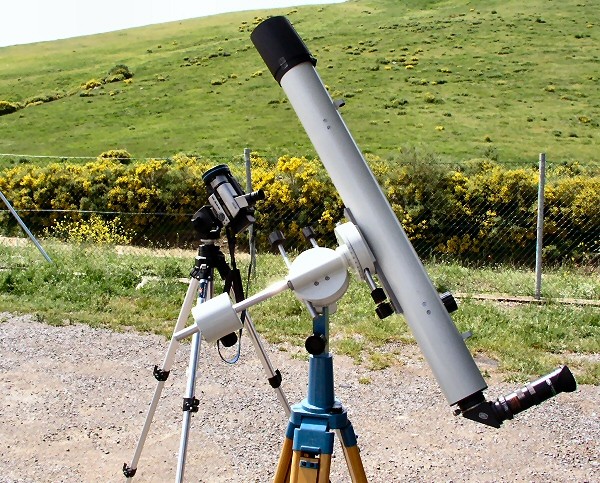
The setup: Aside the Telementor, a Soni
Hi-8 videocamera can be seen with glass-type solar filter
Setting-up the
instruments was a quick task and soon the eye was over
the eyepiece,
showing a really surprising big circular black shape over the sun. I
have never
observed a so sharply defined shape "on" the Sun, despite some years
of solar observing. Never a set of spots had been so contrastly defined
as the
event I was observing.
For taking pictures, I used an Olympus C5050 in afocal mode over the
combination
of a 35mm Eudiascopic plus 2x Celestron Ultima Barlow, yielding 48x.
For
visual, I used TV Naglers in 16mm, 9mm and 4.5mm focal lengths (due to
their
large apparent field of view, Naglers are very nice eyepieces while
using a
Telementor, because the mount has no motors and you must track
manually). I used the 16mm (52x) and 9mm (93) eyepieces the more.
Sadly, there was almost no sun spots, as if the Sun would have decided
to remain
inactive while the Venus show was on the stage. Even so, I clearly
observed two
formations not far from the center of our star and some faculae were
also
visible near the border and not far from Venus' position. However, I
must
say I didn't concentrate on solar features this time.
The video-camera proved invaluable. Back in August 1999 I had used it
for the
famous solar eclipse happening in Europe with a glass based sun-filter.
At 20x
it documents solar phenomena perfectly and it's also very well suited
for Moon
eclipses, being able to reach magnitude 5 stars (the video-camera is
not new,
in fact it doesn't use digital technology, but the Hi-8 system produces
excellent quality). This time I videotaped some stages of the event,
but not
the egress, because at 20x it doesn't offer good resolution for knowing
the
time of contacts.
My strategy for getting a good contacts timing was other: Just the day
before,
I synchronized the internal videocamera's clock with the clock that
runs in my
living-room. It's a digital clock that synchronizes every 24 hours via
radio
with an atomic clock located in Germany, so I estimate the videocamera
is able
to record events with a precision of +/- 0.5 seconds.
We didn't observe the third contact due to a passing cloud, but five
minutes before
fourth contact, my wife started to videotape me while observing the
sun. I was observing with the 4.8mm Nagler at 175x and just when I
didn't see the last "micro-bite" of Venus I
shouted "Ahora, ahora se acabó!" (now, now it finished!). About
two
seconds later I removed the eye from the eyepiece and the videocamera
registered then a relaxed and happy face. Time for fourth
contact was
11:24:35.5 (Universal Time)
After so many weather problems the day before, this transit has been
unforgettable!
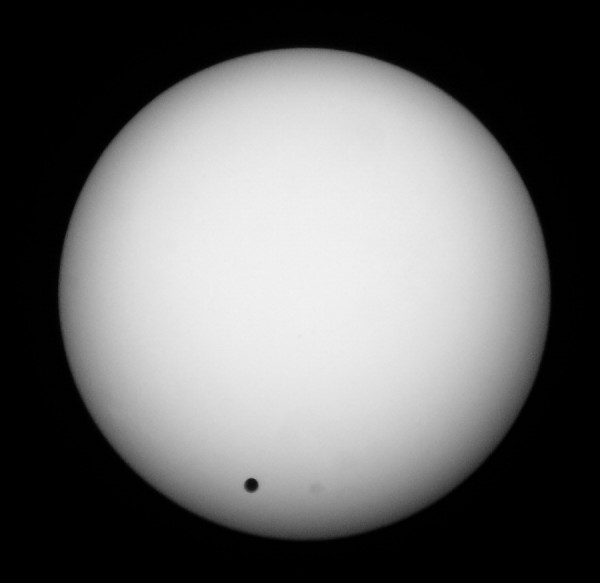
Telementor, Baader Eudiascopic 35mm + 2x Ultima
Barlow, Baader
Sonnenfilterfolie
and Olympus C5050 digital
camera
|
Observer:
Patrick J. Anway
Place: Escanaba,
Michigan, USA. (45°
44' N, 87° 02' W)
|
|

Setup
along the shore of "Bay de Noc" -
Nikon Coolpix 990 camera. Note: "Noc" is a
shortened form of "Noquet".
The Noquets (meaning
"bear") are the Algonquin Indian tribe for whom Bay de Noc is named
Observing conditions:
Seeing: 6
(0-10
scale)
Weather:
Temperature 60º F, clear with
small breeze
Eyepieces: TeleVue 21mm
plossl, William Optic's 24mm plossl
Magnifications:
40x, 35x, 1x (naked eye)
The weather forecasts had
bounced back and forth all
week, from partly cloudy to thunderstorms; believe me I checked often.
Because
of this, I wanted to give myself enough time to find an alternate site
if
needed and so my adventure started at 3:00 am EDT. I checked the
weather one
last time before transit and satellite images showed clouds closing in
from the
northwest, diminishing any possibility of using my primary site near
Munising
overlooking Lake Superior. However, the skies just 50 miles to the
south were
clear and appeared to be out of the path of the front, so I headed out
at about
3:30 EDT in search of a site along the Lake Michigan shoreline. I
arrived in
Escanaba Michigan just over an hour later and went down to the city
park to
check the available horizon. Escanaba juts out into Lake Michigan from
the
western shoreline and therefore the park had a clear view to the
northeast
across the waters of Bay de Noc. My trip had paid off.
After a short trip for a
bagel and a re-supply of
caffeine, I began setting up a little after 5:00 EDT with the transit
about 50
minutes away. I brought three instruments: a Zeiss Telementor 63/840mm
with a
40mm Coronado h-alpha filter, a Zeiss AS 63/840mm with Herschel wedge
and
Celestron 11X80 binoculars with Baader Astrosolar film. I had built the
tube
for the AS63 this winter with the idea of using it for the Venus
transit. I
felt that two scopes of the same aperture and focal length would
provide good
comparison images. I mounted the refractors side-by-side on a Vixen
GPDX mount
and used a TeleVue 21mm plossl in each for 40X and equal full disk
views. With
dawn eliminating any trace of stars, I aligned the mount using a
compass and
this proved to be more than adequate for the low power view. The
binoculars
were placed on a Bogen 501 head atop a Davis & Sanford tripod. I
also had
made up a handheld solar filter from Baader film and cardboard.
There was a thin line of
clouds at the horizon
(probably the clouds over Munising), but other than that the skies
remained
clear for the entire transit. The temperature was 60° F and there
was a light
breeze, really ideal conditions. At first I was alone, but by the time
the
transit had started, 4 individuals, who had heard about the event on
the
evening news the prior day, had joined me and we stood enjoying the
early
morning dawn in anticipation of something none of us had seen before.
Because on the horizon
clouds, the sun did not appear
until about two minutes after predicted sunrise, about 5:57 EDT. I was
able to
see it clearly in both scopes as soon as the rim peaked into view, but
the
Baader film on the binoculars prevented viewing until the sun was more
than
half in view. That didn't matter though, because the real target lay on
the
lower half of the sun. When Venus first made it's appearance at about
6:01, I
was awe struck. My first thought was that it was bigger than I thought
it would
be and next that someone had used the sun as a target and shot a hole
through
it. Those thoughts continued as the sun rose and changed shape from a
somewhat
flattened orange oval to a round yellow-white disk. The seeing was as
expected
at such a low altitude, not good, but I didn't really care - it was
clear and I
was there for the event.
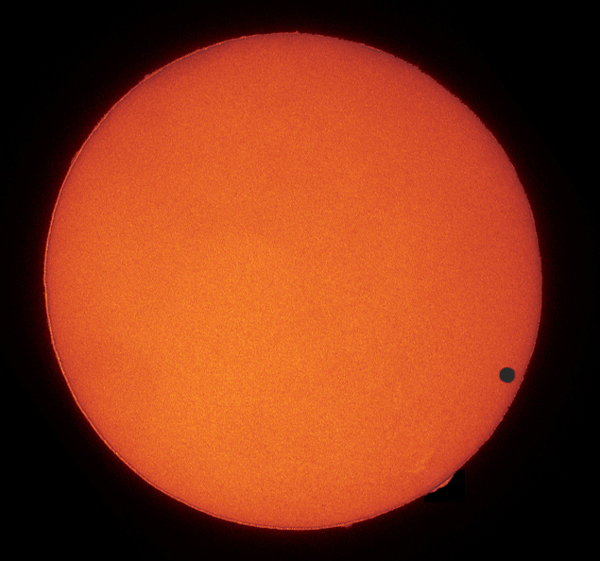
Venus
transit in h-alpha - Telementor, William Optic's
DCL28, Coronado SM40 h-alpha filter, Nikon Coolpix 990 camera
All of us took turns
looking at the three views,
trying to decide which was most appealing. There were many exclamations
of
delight at what we were seeing. The sun was unusually quiet in h-alpha
with
very little surface detail and only a couple of tiny prominences barely
rising
from the limb. I'm sure if it had been active that this would have been
everyone’s number one view, but now the small group of observers was
mixed when
it came to a favorite. I have to admit that I had a hard time deciding,
but I
usually stayed longer at the 11X80's. Maybe it was using both eyes or
maybe the
lower magnification or maybe the slow drift of a faint contrail across
the sun
that made the view so appealing, but it was mesmerizing. I tried a
couple of
times to image through the binoculars with a handheld camera, but was
unsuccessful. We also took turns at using the handheld filter and
trying to
spot the planet, "naked eye". All of us were able to see a small
speck of black on the "quarter-size" solar image.
I waited till everyone
had their fill of views before
attaching the camera to a telescope. I was using a Nikon Coolpix 990
coupled to
a William Optic's DCL28, which is a 24mm plossl and yielded 35X in each
scope. I
like this setup because I can easily moved it from scope to scope. I
made a few
images in both "lights", but fully expected that the seeing would not
yield the desired results. I particularly wanted a shot each in h-alpha
and
"white light" as a keepsake. I took quite a few images, but seeing
wrecked most. I ended up with two h-alpha images - one of the full disk
and a
close up near 4th contact and a few white light images centered around
3rd
contact.
Venus near 4th
contact, h-alpha - Telementor, William Optic's
DCL28, Coronado SM40 h-alpha filter, Nikon Coolpix 990 camera
Third contact was at 7:06
EDT and twenty minutes later Venus was
gone, nearly 90 minutes of transit in all. It was a remarkable
experience, one
that will long be remembered and well worth every effort. Tired, I
began to
pack up with a smile on my face.
PJ Anway
http://www.munisingwebsites.com/lookum
|
|
Observer:
Paolo Morini
Place: Ravenna, Italy
|
|
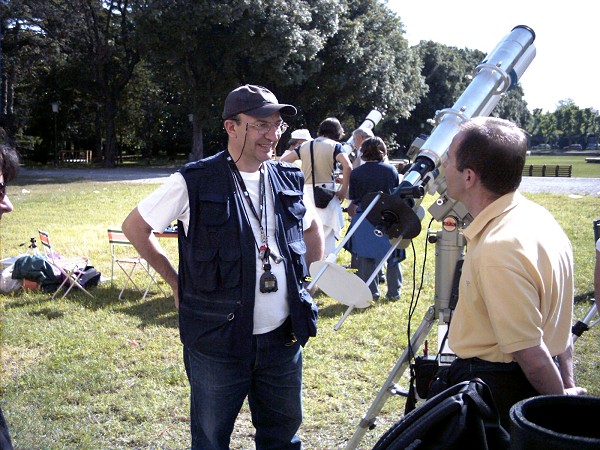
Paolo speaking to a buddy observer in
front of his setup: Telementor Zeiss C/63 optics on selfmade refractor
plus Takahashi FS-102, both mounted on a Vixen GP-DX mount
Observing conditions:
Seeing:
Veru good and clean
Weather:
Sunny, no clouds
Eyepieces:
Several ones
Magnifications:
---
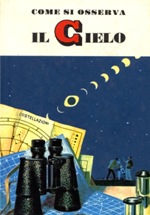 In the pages
of my first practical astronomy book (the Italian edition of 1966 “The
Sky Observer’s Guide”) you can read: In the pages
of my first practical astronomy book (the Italian edition of 1966 “The
Sky Observer’s Guide”) you can read:
“Venus crosses the Sun, like Mercury, but it’s a rare event. The last
transit was in 1882, the next one will occur on year 2004”
I read the book for the
first time 35 years before the 8 June 2004 transit, and it’s hard to
speak about the thrilling atmosphere of the night before the transit,
it resembled the night before the high-school examination.
The weather forecast was fantastic, we were entering in a crystal clear
day.
The observation was set up in Ravenna’s Public Garden, near local
Planetarium, and was managed by the Planetarium itself and run by
amateur astronomer of 2 clubs, ARAR (Associazione Ravennate Astrofili
Rheyta) and ALPA (Associazione del Libero Pensiero Astronomico). We met
at 5:30 in the morning to set up the telescopes and to check all the
stuff.
A bad vibration was around when the RA motor of Marco’s telescope broke
down, and his stopwatch too … but the negative sequence stopped there.
When all the telescope were in place, the observing power was terrific:
- Schmidt
Cassegrain Meade 10” telescope
- Vixen Giant Binoculars 30x125
- Maksutov Cassegrain Skywatcher telescope 5”
- Maksutov Cassegrain Intes telescope 6”
- Two 63 mm Telementor Lens refractors
- Takahashi FS102 4” refractor
- Pentax 75 mm APO refractor
- Vixen M102 4” refractor
- Vixen Binoculars 20x100
- Maksutov Cassegrain Meade EXT 125 telescope
- Vixen Binoculars 10x50
- Russian Binoculars 20x60
- Meade 4” refractor
- Konus 60 mm refractor
My personal setup was the
Takahashi equipped with Herschel prism and the Telementor with Baader
Astrosolar filter.
The sky was incredibly clear, and it was hard to believe when I saw the
notch of Venus on the Sun’s limb, I was only thinking “Yes, I am here
and I am observing the transit of Venus!”
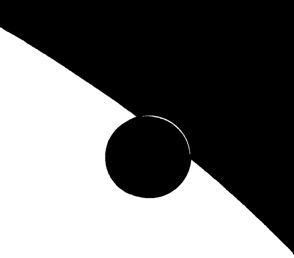
My only “work” was to
take the timings of the internal contacts to send to ESO to collaborate
for an amateur determination of Astronomical Unit.
Waiting for the first
internal contact I saw a thon arc of light surrounding a part of Venus’
disk out of the Sun.
It was stunning, it was the effect of Venus’ atmosphere described by
some astronomers the past, but I was sure it was a minimal phenomena,
at limit of perception.
On the contrary, it was a vision of rare evidence and sharpness.
I spent the morning observing and hosting people at the telescope –
many came to observe with there own eyes the rare event claimed by
newspaper and TV news the day before.
I had also a big number of eclipse and welding filters, and I was able,
and many people with me, to check that the transit was visible without
the telescope – there was a debate about in many astronomical
newsgroups in the months before the transit.
Under some columns in the near complex of Museum “Loggetta Lombardesca”
there was a video projector showing the images of transit get by a web
cam at the focus of the 4” Meade refractor.
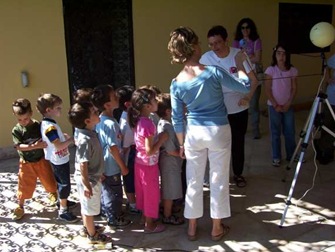
There was also a setup of
panels and a model of Sun-Venus-Earth system showing the mechanic of
transit.
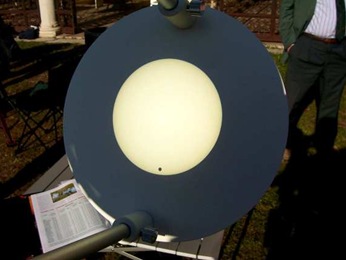
After the 3rd contact, I
have observed again the arc of Venus’ atmosphere, visible both in the
Takahashi than in the Telementor, and I as able to see it until the
center of Venus’ disk was well out the solar limb.
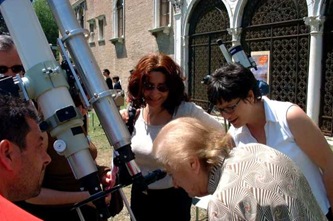
After the 4th contact,
the transit was over, and the Sun disk was desperately and completely
empty, the transit that nobody was able to see after 1882 had taken
place … and finished.
Of all public observations, this is was for sure the most fine and
unique, I think it will remain in the memory not only of us amateur
astronomers, but of the many hundred people that shared the observation
with us.
|
|
|
|